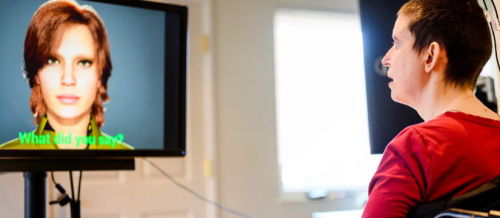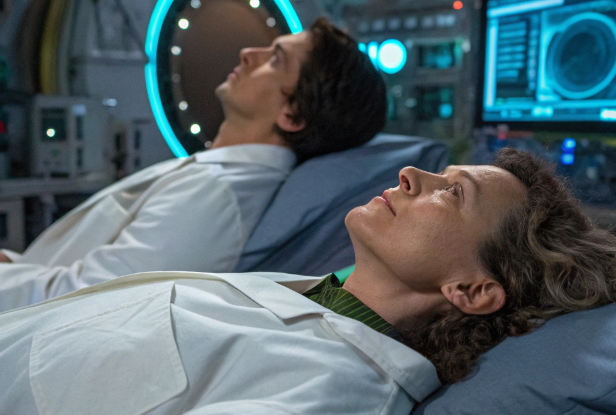AI Technology Restores Paralyzed Woman’s Voice – Science Wins!

© SWNS
If you thought AIs were scary until now, boy oh boy do I have some news for you! AI has been recognized worldwide as a computer system that can create systems to finish tasks instead of humans. While some believe it is revolutionary, others think it is replacing human beings and their jobs. Well, this new revelation is on the revolutionary side. That is because a recent AI Technology restored a paralyzed woman’s voice. How did they do it, and what can we expect next? Let’s find out together!
What is AI technology and what can it do?
AI, or Artificial Intelligence, refers to the simulation of human intelligence processes by computer systems. It involves the development of algorithms, software, and hardware that enable computers to perform tasks that typically require human intelligence.
Some of the main tasks which an AI can deal with include:
- Learning
AI systems can learn from data and improve their performance over time. Additionally, this learning can be supervised (with labeled data), unsupervised (finding patterns in data without labels), or reinforcement-based (learning through trial and error).
- Reasoning
AI can use rules and logic to reach conclusions and make decisions. This includes deductive reasoning (drawing specific conclusions from general principles) and inductive reasoning (making generalizations from specific observations).
- Problem-Solving
AI systems can solve complex problems by searching through possible solutions, evaluating them, and selecting the best one. This is particularly useful in fields like optimization and planning.
- Perception
AI can perceive the world through sensors and data sources. Computer vision, for example, allows machines to interpret and understand visual information, and natural language processing enables machines to understand and generate human language.
- Interaction
AI systems can interact with humans and other systems using natural language, gestures, or other forms of communication. This is often seen in chatbots, virtual assistants, and human-computer interfaces.
Types of AI
AI can be categorized into two main types:
- Narrow or Weak AI: This type of AI is designed for a specific task or a narrow range of tasks. It operates under a limited pre-defined set of conditions and does not possess general intelligence or consciousness. Examples include virtual personal assistants like Siri, recommendation algorithms on streaming platforms, and autonomous driving systems.
- General or Strong AI: This is a more advanced form of AI that possesses human-like intelligence and can perform any intellectual task that a human being can. It has the ability to understand, learn, and apply knowledge across a wide range of domains. General AI is still largely theoretical and does not yet exist in practice.
How AI Technology Restored a Paralyzed Woman’s Voice
A woman named Ann Johnson, who had lost the ability to speak due to a paralyzing stroke, has regained her ability to communicate through an innovative artificial intelligence procedure. The procedure involved the implantation of 253 electrodes into her brain, which were then connected to a computer system through a small port on her head.

These electrodes are strategically placed in the part of the brain responsible for processing speech. They intercept signals from her brain and transmit them to the connected computers. These computers generate a virtual avatar of Johnson, who had chosen the avatar herself.
This on-screen avatar can articulate her thoughts, effectively allowing her to “speak” by using a previously recorded copy of her voice from a 15-minute toast she gave at her wedding. Additionally, the avatar mimics lifelike facial expressions, including blinking, smiling, pursing its lips, and raising eyebrows, creating a more human-like communication experience.
How Was This Possible?
Researchers from the University of California, San Francisco (UCSF), in collaboration with the University of California, Berkeley, have achieved a groundbreaking milestone by synthesizing both speech and facial expressions from brain signals. This achievement marks the first time that both speech and facial expressions have been generated using brain signals.
To train the AI system, the patient, Ann Johnson, silently repeated various phrases from a 1,024-word vocabulary until the computer recognized the corresponding brain activity patterns for each sound. The AI program was designed to recognize phonemes, which are the fundamental units of speech that compose spoken words. For example, the word “Hello” consists of four phonemes: “HH,” “AH,” “L,” and “OW.” By identifying 39 phonemes, the AI program can decode Johnson’s brain signals into complete words at a rate of approximately 80 words per minute, about half the speed of typical person-to-person dialogue.
What This Means For Future Revelations
This groundbreaking procedure not only has the potential to help individuals like Ann Johnson regain their ability to communicate but also represents a significant advancement in the application of artificial intelligence to assist people with disabilities and medical conditions.
The researchers emphasize that the accuracy, speed, and vocabulary of the AI system are critical for achieving more natural and normal conversations, bringing the potential for users to communicate nearly as quickly as people do.
The team is currently working on a wireless version of the system to eliminate the need for physical connections to computers through wires or cables. Dr. Edward Chang, who has been involved in brain-computer interface research for over a decade, hopes that this innovation will lead to the development of a system that can generate speech from brain signals in the near future.
The Downsides of AI Technology
While AI technology offers numerous benefits and has the potential to transform various industries, it also comes with several downsides and challenges:
- Job Displacement
Automation and AI can replace human workers in certain tasks and industries. This can lead to job displacement for individuals who previously performed these tasks, particularly in sectors like manufacturing, customer service, and data entry.
- Bias and Fairness
AI systems can inherit biases present in the data they are trained on. This can result in discriminatory outcomes, reinforcing existing societal biases. For example, biased AI algorithms in hiring may discriminate against certain demographics.
- Privacy Concerns
AI technologies often rely on vast amounts of personal data. Furthermore, the misuse or mishandling of this data can lead to privacy breaches, identity theft, and surveillance concerns. Striking the right balance between data utilization and privacy protection is challenging.
- Security Risks
AI can be exploited by malicious actors for cyberattacks. This can then allow adversarial attacks to manipulate AI systems, making them behave unpredictably. Furthermore, AI can be used to automate and enhance the effectiveness of cyberattacks.
- Transparency and Accountability
Some AI algorithms, particularly deep learning models, are often considered “black boxes” because their decision-making processes are not easily understandable by humans. Moreover, this lack of transparency can make it difficult to determine why AI systems make certain decisions, which can be problematic in critical applications like healthcare and finance.
- Ethical Dilemmas
Additionally, AI can raise ethical questions, such as the use of autonomous weapons, the potential for AI to manipulate public opinion, and the moral implications of AI decision-making in fields like healthcare and criminal justice.
What are your thoughts on AI technology? Are you impressed with how AI technology restored this paralyzed woman’s voice, or are you worried about other AI concerns? Comment down below!
You might also want to read: AI-volution: Animals Take On New Careers


